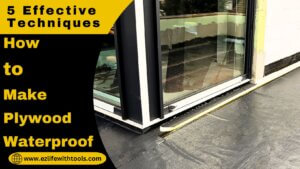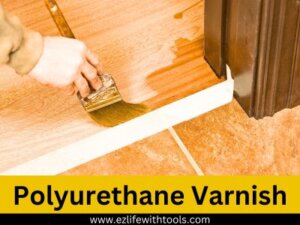How to Make Plywood Waterproof Using Effective Techniques

Commonly, we like to use wooden things for home and office furniture, and we know very well that our population is growing, and it is not in our hands. So, we cannot meet the needs of the whole population for wooden-made goods.
So, we use the alternative of wood, which is called plywood. Plywood is a durable building material that we can use for various projects. But, always remember that plywood is very sensitive, especially when we place it for a long time in an open space exposed to moisture.
Therefore, applying a waterproofing material is necessary to protect the plywood from moisture.
In this article, I will explain how to make plywood waterproof using different methods and materials.
So, keep reading to learn the methods and know about waterproofing material.
Why We Need to Make Plywood Waterproof?
Plywood is made with multiple thin layers of wood veneer glued together under high pressure and heat. The glue holds the layers together and works as water-resistant only, not waterproof.
Because the plywood’s surface has multiple pores, water can seep into those pores. It can affect the structural integrity and appearance of plywood.
Waterproofing material is a protective barrier that repels water and prevents it from penetrating the wood fibers. By applying waterproofing material, we can reduce the chances of damage, and extend the plywood’s life and durability.
What We Need to Make Plywood Waterproof?
Before we start the waterproofing process on plywood, it is necessary to gather some tools and materials to complete the project.
Here is a list of necessary tools materials.
- A waterproofing material of our choice (oil, polyurethane varnish, epoxy, or paint).
- A brush or roller for applying the waterproofing material.
- A sandpaper or sander for smoothing the surface of the plywood.
- A cloth or rag for wiping off dust and excess sealant.
- A protective gear for our eyes, nose, mouth, and hands (goggles, mask, gloves).
- A well-ventilated area or workspace for drying the plywood.
How to Prepare Plywood for Waterproofing
It is necessary to prepare before starting the water proofing process, it will make easy for us to implement all the techniques effectively.
- First of all, we will prepare the surface by sanding it. It will provide a better bond between the wood and the waterproof coating.
- To prepare the surface, we will use sandpaper or a sander, depending on the size and condition of the plywood.
- We will start with coarse-grit sandpaper (80 to 120 grit) and finish with fine-grit sandpaper (180 to 220 grit).
- Our hand direction during sanding should parallel along the fibers of the wood, not against it.
- After sanding the plywood’s sides, we will clean it using a cloth or mineral spirits.
- We will ensure that there are no traces of oil, grease, wax, or dirt on the plywood and that it is completely dry before applying any waterproofing material.
Techniques to Make Plywood Waterproof
Basically here are four effective techniques to make plywood waterproof. We will explain each of them step by step in details.
- Using Oil
- Using Polyurethane Varnish
- Using Epoxy
- Using Paint
1- How to Make Plywood Waterproof with Oil
It is the easiest and cheapest way to make waterproof plywood because oil is a natural substance that penetrates into the plywood fibers and creates a water-repellent layer that prevents moisture.
But we can use different types of oil available in the market on plywood, like Tung oil, boiled linseed oil, or mineral oil. Each oil has its own properties and benefits.
Here are the steps to make plywood waterproof with oil.
- We will apply a thin and even coat of oil on the surface of the plywood using a brush or a roller, covering all sides and edges of the plywood.
- Using a cloth or a rag, wipe off any excess oil that may pool on the surface.
- Before applying the 2nd coat, we will pause for at least 24 hours.
- After applying the final coat, do not put the plywood into the moisture area directly for seven days at least to dry completely.
2- How to Make Plywood Waterproof with Polyurethane Varnish
Polyurethane Varnish is a synthetic resin, and it is used to create a hard and durable coating on the surface of the plywood. It is available in different finishes, like matte, satin, gloss, or semi-gloss. It also protects the plywood from UV rays, scratches, stains, and insects.
There are two types of polyurethane varnish in the market.
- Water-based
- Oil-based
Here are the steps to apply polyurethane varnish.
- We will apply a thin and even coat of polyurethane varnish on the surface of the plywood using a brush or a roller, covering all sides and edges of the plywood.
- Before applying the 2nd coat, we will pause for at least 4 hours. We can apply two to three coats for adequate protection and finish.
- After applying the final coat, do not put the plywood into the moisture area directly for 24 hours at least to dry completely.
Note: Water-based polyurethane varnish is easy to clean and has less odor. However, oil-based polyurethane varnish is more resistant to water and heat.
3- How to Make Plywood Waterproof with Epoxy
Every waterproofing material has its own specifications, so epoxy is a more advanced and effective way to waterproof plywood. It consists of two separate liquids, and we mix them together before applying them on the related surface.
It creates a strong and waterproof bond with the wood fibers, and it is a thick and clear coating that saves the plywood from moisture.
Epoxy also has some additional benefits, like it adds strength and rigidity to the plywood, which makes it more resistant to cracking and warping.
However, it is more expensive and difficult to apply than other waterproofing materials because it has a strong toxic odor and can damage our health, so, we use it in a controlled environment temperature and safety precautions with some specific curing times and precise mixing ratios.
Follow these simple steps to apply the epoxy.
- Get a disposable container and a wooden stick.
- Put the epoxy resin and hardener in the container and mix it well with the help of a wooden spatula for a smooth and consistent mixture.
- Then, apply a thin and even coat of epoxy on the surface of the plywood with the help of a brush or a roller.
- We can apply 2nd coat at least six hours after the first coat for optimal protection. (Maximum four coats).
- After applying the final coat, we will wait at least 72 hours before using it in an open space.
4- How to Make Plywood Waterproof with Paint
It is the most common and simplest way of waterproofing. Paint is a pigmented liquid. It works as a film layer to resist moisture when we apply it. It provides protection against water or moisture and adds beautiful color to plywood that increases the beauty of our goods.
It comes in various textures, colors, and types, like latex paint, acrylic paint, or enamel paint, and we can use it according to our needs and choices.
Follow these simple steps to apply the paint.
- First, we will apply a primer on the surface of the plywood. It will help the paint to stick well.
- After drying the primer coat (2 hours), we will apply a thin and even coat of epoxy on the surface of the plywood with the help of a brush or a roller.
- For Better waterproofing, we can apply 2nd coat at least four hours after the first coat. (Maximum three coats).
- After applying the final coat, we will wait at least 24 hours before using it in an open space.
Important Tips to Make Plywood Waterproof
Once we have done any of the above protection, it does not mean that there is no need to worry further. We will need to keep an eye on it regularly.
Here are some tips to maintain the processed plywood.
- If we see any liquid, dirt, or stain on the plywood that can damage the protection layer, we will wash it with a mild soap or water solution only, not any harsh chemicals.
- If we find any chips, cracks, peeling, or bubbling, we must repair them as soon as possible to prevent further damage to the protection layer.
- If we find any minor damage to the waterproofing layer, we will sand that place with fine-grit sandpaper and apply related waterproofing material.
- In case of major damage, we will cut out the damaged part or replace the entire piece of plywood.
Conclusion
We have discussed many ways to waterproof plywood, and now I am confident you have learned how to make plywood waterproof. But Each method has its pros and cons that you need to consider before choosing one.
Because the method you choose depends on your personal preferences, budget, skill level, and usage of plywood, you can also combine different methods for better results and protection.
Thank you for your time.
Best wishes
Frequently Asked Questions
What can you put on plywood to make it waterproof?
You can apply a waterproof sealant or finish, like polyurethane or marine varnish to make plywood waterproof.
What is the cheapest way to waterproof plywood?
The cheapest way to make waterproof plywood is to use a water-resistant paint or sealant.
How do you permanently waterproof wood?
You can create permanent waterproof wood using combination of waterproof sealers, like epoxy, marine varnish or polyurethane.
What is the best oil for plywood?
The best oil for plywood to make it water-resistant is hard wax oil.
Is plywood waterproof than MDF?
Yes, plywood has more resistance to water than MDF, because MDF board has lot of pores to soak the water.

